Portable Finger Pulse Oximeters
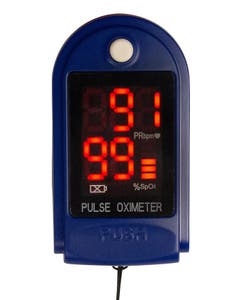 Roscoe Fingertip Pulse OximeterSpecial Price $21.99 Regular Price $43.99Temporary price reductionSave 50%
Roscoe Fingertip Pulse OximeterSpecial Price $21.99 Regular Price $43.99Temporary price reductionSave 50%- Auto Off Function
- Batteries Included
- Heart Rate Monitor Comes With a Lanyard
- Up to 30 Hours of Use on a Single Charge
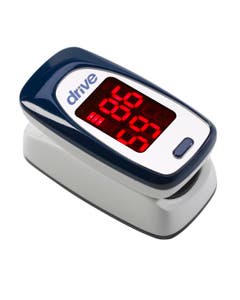 Drive Pulse OximeterSpecial Price $49.00 Regular Price $59.00Temporary price reductionSave 17%
Drive Pulse OximeterSpecial Price $49.00 Regular Price $59.00Temporary price reductionSave 17%- Easy-to-read LED display
- Displays SpO₂ and pulse rate
- Perfect for any patient
- Includes lanyard and two AAA batteries.
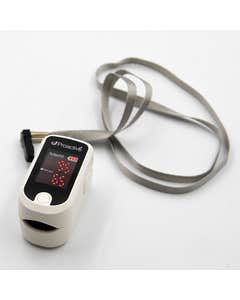 Proactive Pulse OximeterSpecial Price $24.58 Regular Price $69.95Temporary price reductionSave 65%
Proactive Pulse OximeterSpecial Price $24.58 Regular Price $69.95Temporary price reductionSave 65%- Lightweight
- Portable
- Easy to use
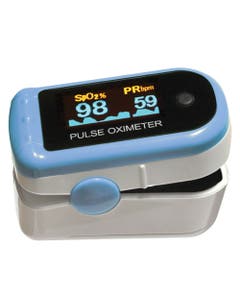 Sunset Health Advanced Finger Pulse Oximeter$53.99
Sunset Health Advanced Finger Pulse Oximeter$53.99- Six display modes and a dual-colored led display
- More than 30-hours of battery life
- Light and compact design
- Suitable for both children and adults
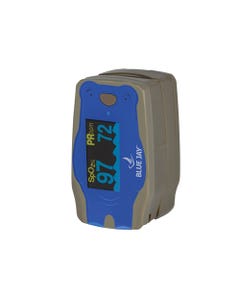 Blue Jay Pediatric Blue Bear Pulse Oximeter$39.99
Blue Jay Pediatric Blue Bear Pulse Oximeter$39.99- OLED screen with 4-direction display
- Pule bar, Plethysmogram
- Parameters; SpO2, PR
- Low battery prompt - Takes 2 "AAA" batteries (included)
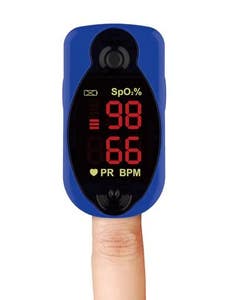 Blue Jay Comfort Fingertip Pulse Oximeter$34.99Out of stock
Blue Jay Comfort Fingertip Pulse Oximeter$34.99Out of stock- Large and bright digital LED one-way display
- Uses two AAA batteries (can be continuously operated for 30 hours)
- Clear rubber boot included
- 1-year limited warranty
Portable Fingertip Pulse Oximeters
For patients suffering from COPD, asthma, and other respiratory-related illnesses, pulse oximeter monitors are part of the daily routine. Our selection of portable pulse oximeters makes it easy to measure blood oxygen saturation levels and pulse rates non-invasively wherever you are. These small battery-operated pulse oximeters are easy to take with you wherever you go.
At The Oxygen Concentrator Supplies Shop, we take pride in providing our customers with pulse oximeters that exceed today’s regulatory standards. Get accurate, easy-to-interpret results faster! If you are unsure about what product best meets your needs or have any questions, please contact us so we can help review your options.
As a top portable pulse oximeter distributor, we receive many general questions from our online pulse oximeter buyers. Here we have listed their most common questions with our answers for your convenience:
Read more about the best pulse oximeters here.
Frequently Asked Questions for Portable Finger Pulse Oximeters
What is a Fingertip Portable Pulse Oximeter?
A portable pulse oximeter is a medical device that helps you monitor your SpO2 levels in blood and pulse or heart rate. The device displays the results in percentage which is updated with each pulse wave.
How Does A Portable Finger Pulse Oximeter Work?
The principle on which a portable finger pulse oximeter works is based on the fact that oxygenated blood absorbs more light than non-oxygenated blood. It assesses the amount of oxygen in the hemoglobin of the blood by using two different types of LED lights (red and infrared) flashed in beams into the skin. The light passes through the skin and blood, and then a sensor measures the reflection of light which determines the percentage of oxygen carried by the blood.
How To Use A Portable Pulse Oximeter Or SpO2 Monitor?
Portable pulse oximeters, or SpO2 monitors, are non-evasive and can provide you with very accurate readings. Before the invention of pulse oximeters, doctors had to collect blood samples to determine the percentage of SpO2 saturation in the blood and run several tests and analyses.
Using a portable pulse oximeter is very easy. You can clamp the device on your right middle finger, toe, or earlobe and it will provide you with an accurate reading. Several models act as surface probes that you can mount to the forehead or chest. The idea is to limit the movement of the patient to get accurate, immediate, practical readings. When you use a portable finger pulse oximeter, it is best to remove any nail polish.
Pulse oximeters achieve a reliable reading of oxygen saturation in arterial blood after a few seconds. Pulse oximeters are very helpful in emergencies and in cases where continuous real-time monitoring of the vital signs of a patient is necessary.
What Are The Risks Of Using A Finger Pulse Oximetry?
Fortunately, the use of a pulse oximeter is free from any dangers or hazards. Making sure that the system provides a correct reading is the only concern. Physicians, respiratory therapists, and medical practitioners rely on portable finger pulse oximeters for reliable readings.
What Are The Advantages Of Portable Pulse Oximeters?
Most portable oximeters clamp to a patient’s finger, meaning that they are non-invasive and blood testing is no longer required. They make it easy to monitor blood oxygen levels at home and are used by pilots, mountain climbers, and athletes. Readings are fast and accurate.
Which Finger Is Best For Pulse Oximeters?
This type of pulse oximeter is specifically made to be used on a finger, and you can put it on any finger except the thumb for reliable readings..
How Accurate Are Finger Pulse Oximeters?
The accuracy of a pulse oximeter is often compared to the readings obtained by an arterial blood gas test. The pulse oximeter is much more convenient than the blood gas test and it starts showing data very quickly. A small margin of error of around 2% has been noted in most finger pulse oximeters implying that a reading of 93% will mean the actual reading can be somewhere between 91% to 95%. This reading is accurate enough for pulse oximeters to commonly be used as monitors for blood oxygen levels. In order to get the most accurate reading, remove nail polish and makeup.
What Is A Normal Reading On A Finger Pulse Oximeter?
If you are planning to use this portable pulse oximeter at home then you should be aware of normal oxygen percentages for an average human being. On a pulse oximeter, the normal readings range from 95% to 100% while a reading below 90% is considered unsafe and Portable Oxygen Concentrators are suggested. .
What Are The Two Numbers On A Pulse Oximeter?
Blood Oxygen Level
A finger pulse oximeter shows blood oxygen saturation (also referred to as SpO2) which is an estimated value of the amount of oxygen in your blood. As mentioned above, the normal percentage for SpO2 is at or above 95% and if the SpO2 reading is 92% or less (at sea level) it is a sign of poorly saturated blood. Low oxygen saturation can result in a variety of health conditions such as chest pain, shortness of breath, and increased heart rate.
Pulse Rate
The number of times your heart contracts in 60 seconds is called pulse rate. The ideal value considered for pulse rate in adults ranges from 60-100 beats per minute (BPM). Typically, while at rest a lower heart rate indicates better efficiency of heart function, in spite of that, if the pulse rate goes below 60 BPM then it may indicate Bradycardia.
How Do You Read A Portable Pulse Oximeter?
The portable pulse oximeter device comes with a digital display that shows your blood saturation and pulse rate whether you are at home or on the go. You can differentiate the pulse rate and blood oxygen level on the screen of a finger pulse oximeter because they are clearly labeled with symbols. Usually a heart or pulsing light indicates the pulse rate on the digital display whereas the percentage of blood oxygen saturation is denoted by the symbol "SpO2".
For more information, read our detailed blog on portable oximeters.
Is There A Warranty On Portable Finger Pulse Oximeters?
The Oxygen Concentrator Supplies Shop offers pulse oximeters with a manufacturer warranty and you can check each product description to learn more about a specific product.
What If My Purchase Does Not Work Out For Me?
If the pulse oximeter does not meet your needs or is defective, you can return it. Please read our return policy here to see what is involved.
Is Insurance Covered On My Pulse Oximeter?
The Oxygen Concentrator Supplies Shop does not deal directly with insurance companies, and it is always best to consult with your insurance carrier to see whether this medical device is covered.
Is Shipping Free On A Portable Pulse Oximeter?
Buy your pulse oximeter from The Oxygen Concentrator Supplies Shop and enjoy free shipping on orders above $99. We also provide special discounts on offers from time to time so sign up to be notified about those special deals and shop with us now.
Portable Fingertip Pulse Oximeters
For patients suffering from COPD, asthma, and other respiratory-related illnesses, pulse oximeter monitors are part of the daily routine. Our selection of portable pulse oximeters makes it easy to measure blood oxygen saturation levels and pulse rates non-invasively wherever you are. These small battery-operated pulse oximeters are easy to take with you wherever you go.
At The Oxygen Concentrator Supplies Shop, we take pride in providing our customers with pulse oximeters that exceed today’s regulatory standards. Get accurate, easy-to-interpret results faster! If you are unsure about what product best meets your needs or have any questions, please contact us so we can help review your options.
As a top portable pulse oximeter distributor, we receive many general questions from our online pulse oximeter buyers. Here we have listed their most common questions with our answers for your convenience:
Read more about the best pulse oximeters here.
Frequently Asked Questions for Portable Finger Pulse Oximeters
What is a Fingertip Portable Pulse Oximeter?
A portable pulse oximeter is a medical device that helps you monitor your SpO2 levels in blood and pulse or heart rate. The device displays the results in percentage which is updated with each pulse wave.
How Does A Portable Finger Pulse Oximeter Work?
The principle on which a portable finger pulse oximeter works is based on the fact that oxygenated blood absorbs more light than non-oxygenated blood. It assesses the amount of oxygen in the hemoglobin of the blood by using two different types of LED lights (red and infrared) flashed in beams into the skin. The light passes through the skin and blood, and then a sensor measures the reflection of light which determines the percentage of oxygen carried by the blood.
How To Use A Portable Pulse Oximeter Or SpO2 Monitor?
Portable pulse oximeters, or SpO2 monitors, are non-evasive and can provide you with very accurate readings. Before the invention of pulse oximeters, doctors had to collect blood samples to determine the percentage of SpO2 saturation in the blood and run several tests and analyses.
Using a portable pulse oximeter is very easy. You can clamp the device on your right middle finger, toe, or earlobe and it will provide you with an accurate reading. Several models act as surface probes that you can mount to the forehead or chest. The idea is to limit the movement of the patient to get accurate, immediate, practical readings. When you use a portable finger pulse oximeter, it is best to remove any nail polish.
Pulse oximeters achieve a reliable reading of oxygen saturation in arterial blood after a few seconds. Pulse oximeters are very helpful in emergencies and in cases where continuous real-time monitoring of the vital signs of a patient is necessary.
What Are The Risks Of Using A Finger Pulse Oximetry?
Fortunately, the use of a pulse oximeter is free from any dangers or hazards. Making sure that the system provides a correct reading is the only concern. Physicians, respiratory therapists, and medical practitioners rely on portable finger pulse oximeters for reliable readings.
What Are The Advantages Of Portable Pulse Oximeters?
Most portable oximeters clamp to a patient’s finger, meaning that they are non-invasive and blood testing is no longer required. They make it easy to monitor blood oxygen levels at home and are used by pilots, mountain climbers, and athletes. Readings are fast and accurate.
Which Finger Is Best For Pulse Oximeters?
This type of pulse oximeter is specifically made to be used on a finger, and you can put it on any finger except the thumb for reliable readings..
How Accurate Are Finger Pulse Oximeters?
The accuracy of a pulse oximeter is often compared to the readings obtained by an arterial blood gas test. The pulse oximeter is much more convenient than the blood gas test and it starts showing data very quickly. A small margin of error of around 2% has been noted in most finger pulse oximeters implying that a reading of 93% will mean the actual reading can be somewhere between 91% to 95%. This reading is accurate enough for pulse oximeters to commonly be used as monitors for blood oxygen levels. In order to get the most accurate reading, remove nail polish and makeup.
What Is A Normal Reading On A Finger Pulse Oximeter?
If you are planning to use this portable pulse oximeter at home then you should be aware of normal oxygen percentages for an average human being. On a pulse oximeter, the normal readings range from 95% to 100% while a reading below 90% is considered unsafe and Portable Oxygen Concentrators are suggested.
What Are The Two Numbers On A Pulse Oximeter?
Blood Oxygen Level
A finger pulse oximeter shows blood oxygen saturation (also referred to as SpO2) which is an estimated value of the amount of oxygen in your blood. As mentioned above, the normal percentage for SpO2 is at or above 95% and if the SpO2 reading is 92% or less (at sea level) it is a sign of poorly saturated blood. Low oxygen saturation can result in a variety of health conditions such as chest pain, shortness of breath, and increased heart rate.
Pulse Rate
The number of times your heart contracts in 60 seconds is called pulse rate. The ideal value considered for pulse rate in adults ranges from 60-100 beats per minute (BPM). Typically, while at rest a lower heart rate indicates better efficiency of heart function, in spite of that, if the pulse rate goes below 60 BPM then it may indicate Bradycardia.
How Do You Read A Portable Pulse Oximeter?
The portable pulse oximeter device comes with a digital display that shows your blood saturation and pulse rate whether you are at home or on the go. You can differentiate the pulse rate and blood oxygen level on the screen of a finger pulse oximeter because they are clearly labeled with symbols. Usually a heart or pulsing light indicates the pulse rate on the digital display whereas the percentage of blood oxygen saturation is denoted by the symbol "SpO2".
For more information, read our detailed blog on portable oximeters.
Is There A Warranty On Portable Finger Pulse Oximeters?
The Oxygen Concentrator Supplies Shop offers pulse oximeters with a manufacturer warranty and you can check each product description to learn more about a specific product.
What If My Purchase Does Not Work Out For Me?
If the pulse oximeter does not meet your needs or is defective, you can return it. Please read our return policy here to see what is involved.
Is Insurance Covered On My Pulse Oximeter?
The Oxygen Concentrator Supplies Shop does not deal directly with insurance companies, and it is always best to consult with your insurance carrier to see whether this medical device is covered.
Is Shipping Free On A Portable Pulse Oximeter?
Buy your pulse oximeter from The Oxygen Concentrator Supplies Shop and enjoy free shipping on orders above $99. We also provide special discounts on offers from time to time so sign up to be notified about those special deals and shop with us now.



